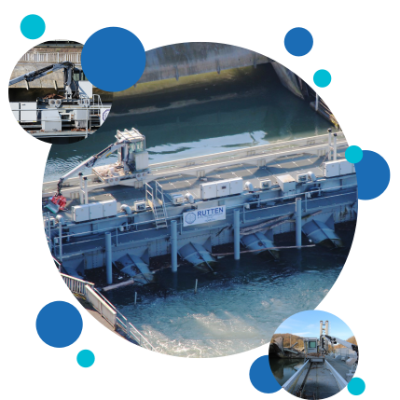Hydroelectric turbines without civil engineering

For the past 30 years, Rutten Electromécanique has been developing high-performance hydroelectric turbine concepts for low heads between 1.6 and 4 m. The absence of civil engineering is the first goal developed by the company. Rutten turbines are therefore designed to be adapted to existing fixed dams (automated sluices, stone dams, needle dams, etc.).
Video presentation
To learn more about Rutten turbines, watch the video presentation below.
Our product




Omega D
The OMEGA D turbine eliminates the cost of building a forebay by integrating the turbines directly into a floating structure anchored downstream of one of the existing dam's openings.
The floating structure is made up of juxtaposed modules. It incorporates 1 to 10 turbines absorbing 18 m³/s to 180 m³/s (i.e. 18 m³ per turbine for a waterfall of 3.1 m). The number of turbines activated is automatically regulated according to the available flow.
Goals
Without civil engineering
The absence of civil engineering is the first goal developed by the company. Rutten turbines are therefore designed to be adapted to existing fixed dams (automated openings, rock dams, needle dams, etc.).
Low waterfalls
Over the past 30 years, Rutten Electromécanique has developed high-performance hydroelectric turbine concepts for low heads between 1.6 and 4 meters. On all the world's rivers, the profitability of building a hydroelectric power station is justified for falls in excess of 4 meters. To ensure navigation, most existing dams are below 4 meters.
Profitability
For these low warterfalls (1.6 to 4 m), the cost of civil engineering completely undermines the profitability of the project. Considering that the cost of civil engineering for a “conventional” power plant represents 70 to 85% of the total investment, the installation of a conventional hydroelectric plant has always proved unprofitable for low waterfalls, given the power installed and the energy recovered.
Rutten Electromécanique has developed hydroelectric power plant models that require no civil engineering, making them eminently cost-effective!



